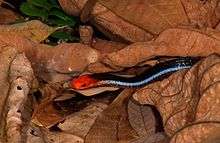Calliophis bivirgatus
Calliophis bivirgatus is a species of snake in the family Elapidae known commonly as the blue coral snake[1] or blue Malayan coral snake.[2][3] It is native to Southeast Asia.[1]
| Calliophis bivirgatus | |
|---|---|
 | |
| Scientific classification | |
| Kingdom: | Animalia |
| Phylum: | Chordata |
| Class: | Reptilia |
| Order: | Squamata |
| Suborder: | Serpentes |
| Family: | Elapidae |
| Genus: | Calliophis |
| Species: | C. bivirgatus |
| Binomial name | |
| Calliophis bivirgatus (F. Boie, 1827) | |
| Synonyms | |
Geographic range and distribution
This terrestrial snake occurs in Brunei, Indonesia, Malaysia, Singapore, Thailand,[1] and Burma.[3] It lives at 100 to 1100 meters in elevation.[1]
There are three subspecies:[3]
- C. b. bivirgatus – Indonesia
- C. b. flaviceps – Indonesia, Malaysia, Thailand, Singapore, Burma
- C. b. tetrataenia – Indonesia, Malaysia, Brunei
Description
This species was assigned to the new world coral snake genus Maticora until phylogenetic studies revealed this species to be nested within the tropical coral snake species clade Calliophis and sister species to Calliophis intestinalis, the banded Malaysian coral snake.[4]
This is a medium-sized coral snake with a slender body. The adult can reach 1.8 meters long. It has a red head, tail and belly. The back is dark blue to black in color, and it usually has a large blue[2] or white stripe on each flank.[5]
The snake, especially when juvenile, is often confused with the pink-headed reed snake (Calamaria schlegeli) as they share similar habitat and appearance. But the latter is much smaller, reaching a maximum length of 50 cm (20 in). The reed snake is nonvenomous, while the coral snake is potentially lethal.[2][3] They also are very similar to another venomous snake, the red-headed krait (Bungarus flaviceps).
Biology
This uncommon snake is considered semi-fossorial and is found in the leaf litter of primary and secondary forests.[1] It preys on other snakes. When threatened it usually flees, but it may remain in place with its red tail erect as a defensive message.[2]
Venom
The potent venom has very occasionally caused human deaths.[6] This species has unusually long venom glands, extending to 25% of the length of the body.[6]
Unlike other snakes of the family Elapidae, its venom does not contain a neurotoxin.[6] The toxic element is a cytotoxin that leads to the destruction of muscle tissue and is primarily a sodium channel blocker. Phosphodiesterases promote the release of adenosine, which causes hypotension, inflammation, and neurotransmitter blockade in prey items and other bite victims.[6]
As they frequently feed on other venomous snakes, the venom has evolved to be extremely fast acting causing rapid convulsion and paralysis, and has more characteristics in common with scorpion venom. No antidote currently exists, and research is being conducted on the venom as potential alternative analgesics. [7]
See also
References
| Wikimedia Commons has media related to Calliophis bivirgatus. |
- Grismer, L. & Chan-Ard, T. 2012. Calliophis bivirgata. The IUCN Red List of Threatened Species. Downloaded on 18 February 2016.
- Calliophis bivirgatus. Ecologyasia. 2016.
- Calliophis bivirgata. Reptile Database.
- J. B. Slowinski, J. Boundy and R. Lawson. 2001. The phylogenetic relationships of Asian coral snakes (Elapidae: Calliophis and Maticora) based on morphological and molecular characters. Herpetologica 57(2) 233-245
- Coral snakes: colors, bites, farts, and facts. Livescience. 16 December 2014.
- Tan, C. H., et al. (2015). Unveiling the elusive and exotic: Venomics of the Malayan blue coral snake (Calliophis bivirgata flaviceps). Journal of Proteomics 132, 1.
- "The Venom From This Beautiful Snake Will Murder You Horribly". ScienceAlert. ScienceAlert. Retrieved 29 July 2019.
Further reading
- Boie F. 1827. "Bemerkungen über Merrem's Versuchs eines Systems der Amphibien. 1te Lieferung: Ophidier ". Isis von Oken 20: 508-566. (Elaps bivirgatus, p. 556).
- Boulenger GA. 1896. Catalogue of the Snakes in the British Museum (Natural History). Volume III., Containing the Colubridæ (Opisthoglyphæ and Proteroglyphæ), ... London: Trustees of the British Museum (Natural History). (Taylor and FRancis, printers). xiv + 727 pp. + Plates I-XXV. (Doliophis bivirgatus, pp. 400–401).
- Das I. 2006. A Photographic Guide to Snakes and Other Reptiles of Borneo. Sanibel Island, Florida: Ralph Curtis Books. 144 pp. ISBN 0-88359-061-1. (Calliophis bivirgata [sic], p. 61).
- Oshea, Mark; Halliday, Tim; Metcalf, Jonathan (editor). 2002. Reptiles and Amphibians: Smithsonian Handbooks. London: DK (Dorling Kinderley). 256 pp. ISBN 9780789493934.
